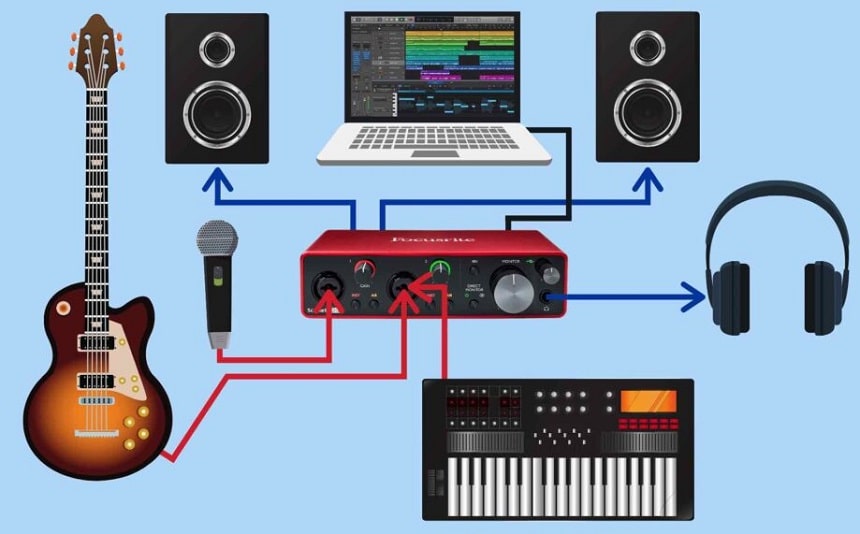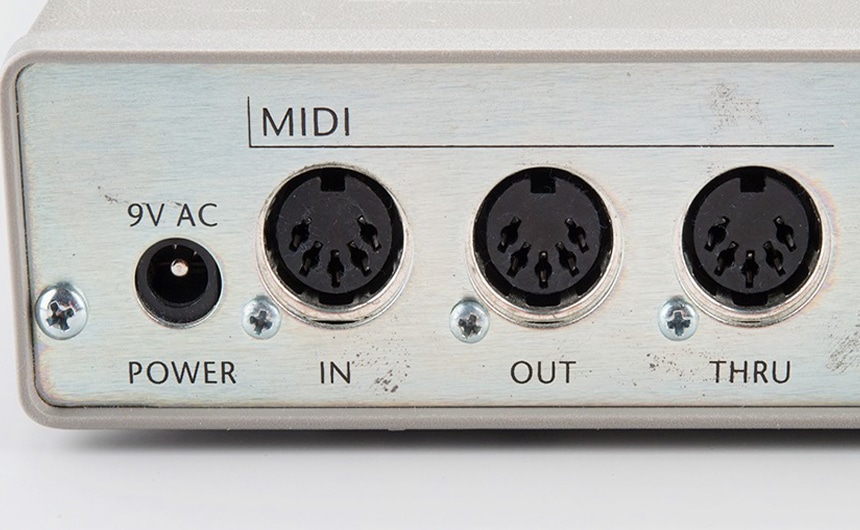Let’s assume you just got started in the music production industry and of course you have your computer with a program to create the music in. Assuming this program is the likes of Reaper Trusted Source REAPER | Audio Production Without Limits REAPER is a complete digital audio production application for computers, offering a full multitrack audio and MIDI recording, editing, processing, mixing and mastering toolset. www.reaper.fm and Logic Pro Trusted Source Logic Pro - Apple Logic Pro is a complete professional recording studio on the Mac. And it has everything musicians need to go from first note to final master. www.apple.com it can work with a built-in audio card. This stops you in your tracks and you ask yourself: why do I need an audio interface?
An audio interface will allow you to convert microphone and instrument signals into a format that your software and computer recognize. It also transfers audio from your computer to your headphones or studio monitors. You don’t have to break the bank for an audio interface. Even the cheapest of them sounds great. You can get a high-performing audio interface under 100 dollars.
So many beginner producers have no idea what an audio interface is. Basically, an audio interface consists of:

When creating music, the instruments you are using, i.e. electric guitar, or microphone should plug into something to get into your computer. The sound produced by the instrument also has to come back to your speakers. Your audio interface has the INS for plugging your instrument and the outs for sending back audio to your speakers.
Whenever you use a microphone, it goes through a preamp to amplify its signal. Something has to convert the signal to digital so that your DAW understands it because you microphone is analog. That thing is called A/D.
Whenever you mix out of your DAW to your headphones or speakers that are analog, something has to convert the digital information in your DAW to analog. That this is called D/A

These come in handy when you need to connect MIDI keyboards that cannot connect via USB. Although interfaces with MIDI ports are not so popular nowadays because USB based MIDI keyboards and controllers have become the order of the day.
This is used with condenser microphones which require much more boosting than dynamic microphones.
There isn’t a microphone that can put out enough signal for the DAW to usably record it. The microphone preamp boosts the level of your microphone’s signal for recording.
Headphone amp
This allows you to listen through headphones.
So why do you really need an audio interface? Your computer has a built-in audio with a stereo-input, stereo-output and a headphone jack. Its only drawback is that it is consumer grade quality and won’t allow you to get the best professional sounds you want. Also, it won’t have all the connectivity you need.
With an audio interface, your headphone input will have better gain and clearer sound. In a nutshell, a good audio interface will offer you way better connectivity options and better converters with less noise and latency compared to your built-in sound card.
Back in the day, you only had to have enough dough to get yourself an interface with multiple I/Os and decent converters and mic press. You could also easily get one that went into your computer via a PCI slot or Firewire. These days, features are all you look at when choosing an audio interface.
If you are a beginner, you can opt for the best beginner audio interfaces that offers great value for money. If you are an advanced beginner or you are just looking to invest in a more expensive option, here’s what you are likely to get:

More Ins and Outs will allow you to record an entire drum kit. You will use the inputs for more microphones than just recording your voice and guitar simultaneously.
these will allow you to record multiple instruments discretely simultaneously.
High-end audio interfaces don’t have lower latency issues. Although this has increasingly become less of an issue nowadays.
it is not guaranteed that expensive audio interfaces have way better converters than inexpensive options. The difference is not that significant but it exists. If you are not happy with the performance of your converters, you can always buy standalone converters to improve their quality.
According to most user reviews the Yamaha RSio64-D Dante/Mini-YGDAI converting audio interface must be the best converting audio interface out there. It has myriad I/O and processing options with 7 general routing presets.
The Maono audio interface with a DJ mixer and a sound card is another popular option. It remains one of the most acclaimed audio interfaces for podcast production. It is easily portable, and can be used with a microphone for guitar, live streaming, recording, PC, and gaming. Its most distinguishing feature is its ability to work both as a sound card and mixing station.
As a beginner producer, better known as bedroom producers, you must have realized that one of the things you need to learn early is how to get sound into and out of your computer. At some point, you must have asked yourself questions like; why do I need an audio interface on dj controller? An audio interface makes a whole difference in your music production. It improves your sound quality, impacts your recording speed and accuracy and is super-convenient.
The good thing is you don’t have to break the bank to own an audio interface. There are so many budget options in the market that sound great. If you are doubtful of a certain model or brand, you can always check user reviews on the brand’s website to see people’s experiences with the interface.